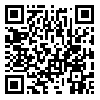Fri, Nov 28, 2025
Volume 10, Issue 3 (7-2021)
2021, 10(3): 16-19 |
Back to browse issues page
Download citation:
BibTeX | RIS | EndNote | Medlars | ProCite | Reference Manager | RefWorks
Send citation to:



BibTeX | RIS | EndNote | Medlars | ProCite | Reference Manager | RefWorks
Send citation to:
Janani A, Asghari M, Maleki A, Ziaie P, Mahjoub P. Research Paper: The Prevalence of Ectopically Maxillary Canine and Related Factors in an Iranian Population: A Retrospective Study. Journal title 2021; 10 (3) :16-19
URL: http://3dj.gums.ac.ir/article-1-498-en.html
URL: http://3dj.gums.ac.ir/article-1-498-en.html
1- Assistant Professor, Dental Sciences Research Center, Department of Pediatric Dentistry, School of Dentistry, Guilan University of Medical Sciences, Rasht, Iran
2- Postgraduate resident of Orthodontics, School of Dentistry, Guilan University of Medical Sciences, Rasht, Iran
3- Dentist
4- Student Research Committee, School of Dentistry, Guilan University of Medical Sciences, Rasht, Iran
2- Postgraduate resident of Orthodontics, School of Dentistry, Guilan University of Medical Sciences, Rasht, Iran
3- Dentist
4- Student Research Committee, School of Dentistry, Guilan University of Medical Sciences, Rasht, Iran
Abstract: (1445 Views)
Abstract
Introduction: Maxillary canines commonly have an ectopic eruption. This study aimed to assess the factors related to the ectopic maxillary permanent canines.
Materials and Methods:This was a descriptive cross-sectional study of 1357 panoramic radiographs from patients 8 to 13 years old. The radiography was excluded if the patient had any developmental disease or if the panoramic image had poor quality. The ectopic canine was determined. It was also detected whether the ectopic canine was unilateral or bilateral. The quadrant of the ectopic canine, the presence of missing teeth, supernumerary teeth and other teeth with ectopic eruption were also reported. Data was analyzed using SPSS version 24 applying the Chi-square test at 0.05 significance level.
Results: Among the 1126 panoramic radiographs, 11.4% (128) had at least one canine with ectopic eruption. 64.1% (82) of patients with at least one ectopic canine were female and 35.9% (46) were male. (P=0.027) 69.5% (89) had unilateral ectopic canine and 30.5% (39) had bilateral ectopic canines. (P=0.001) 10.9% (14) of participants had missing teeth. 34.4% (44) of cases had other teeth with ectopic eruption and 3.1% (4) of cases had supernumerary teeth. The accompaniment of ectopic canine with other ectopic teeth was statistically significant. (P=0.022)
Conclusion:Ectopic maxillary canines with the prevalence of 11.4% were more common in females; were mostly located unilaterally, and were found with other teeth with ectopic eruptions.
Introduction: Maxillary canines commonly have an ectopic eruption. This study aimed to assess the factors related to the ectopic maxillary permanent canines.
Materials and Methods:This was a descriptive cross-sectional study of 1357 panoramic radiographs from patients 8 to 13 years old. The radiography was excluded if the patient had any developmental disease or if the panoramic image had poor quality. The ectopic canine was determined. It was also detected whether the ectopic canine was unilateral or bilateral. The quadrant of the ectopic canine, the presence of missing teeth, supernumerary teeth and other teeth with ectopic eruption were also reported. Data was analyzed using SPSS version 24 applying the Chi-square test at 0.05 significance level.
Results: Among the 1126 panoramic radiographs, 11.4% (128) had at least one canine with ectopic eruption. 64.1% (82) of patients with at least one ectopic canine were female and 35.9% (46) were male. (P=0.027) 69.5% (89) had unilateral ectopic canine and 30.5% (39) had bilateral ectopic canines. (P=0.001) 10.9% (14) of participants had missing teeth. 34.4% (44) of cases had other teeth with ectopic eruption and 3.1% (4) of cases had supernumerary teeth. The accompaniment of ectopic canine with other ectopic teeth was statistically significant. (P=0.022)
Conclusion:Ectopic maxillary canines with the prevalence of 11.4% were more common in females; were mostly located unilaterally, and were found with other teeth with ectopic eruptions.
Keywords: Tooth Eruption, Ectopic
Cuspid
Prevalence
Type of Study: Original article |
Subject:
General
Received: 2021/08/8 | Accepted: 2021/08/18 | Published: 2021/08/18
Received: 2021/08/8 | Accepted: 2021/08/18 | Published: 2021/08/18
| Rights and permissions | |
 | This work is licensed under a Creative Commons Attribution-NonCommercial 4.0 International License. |





